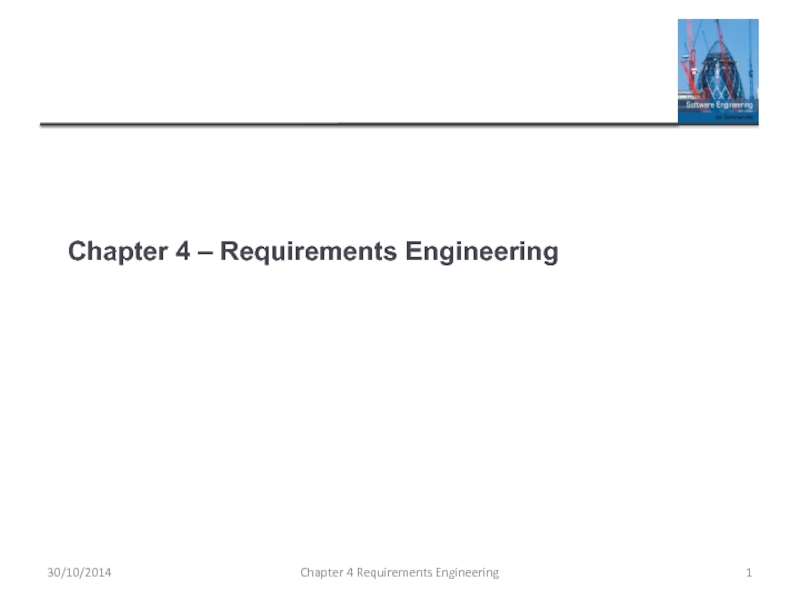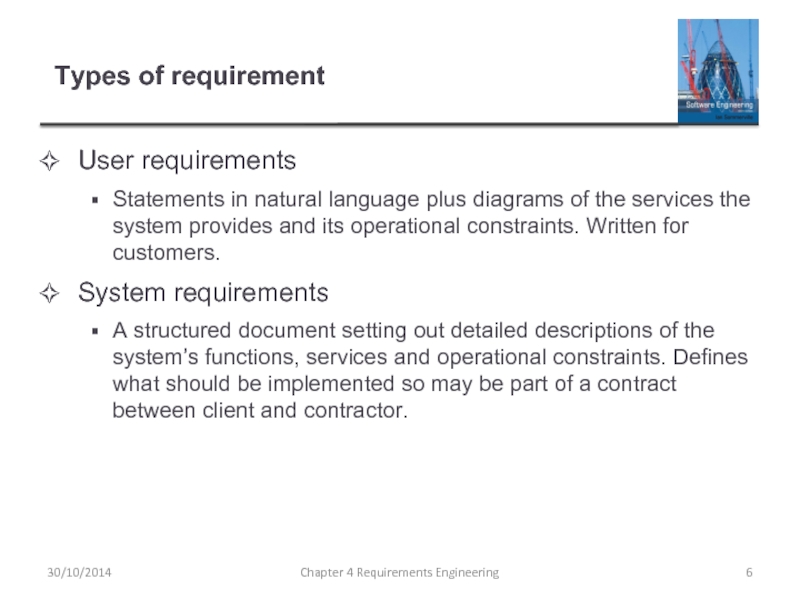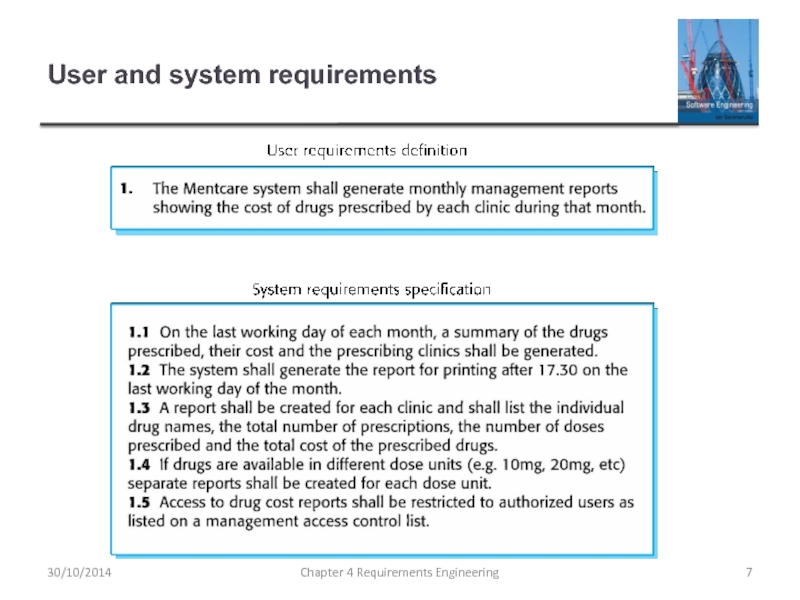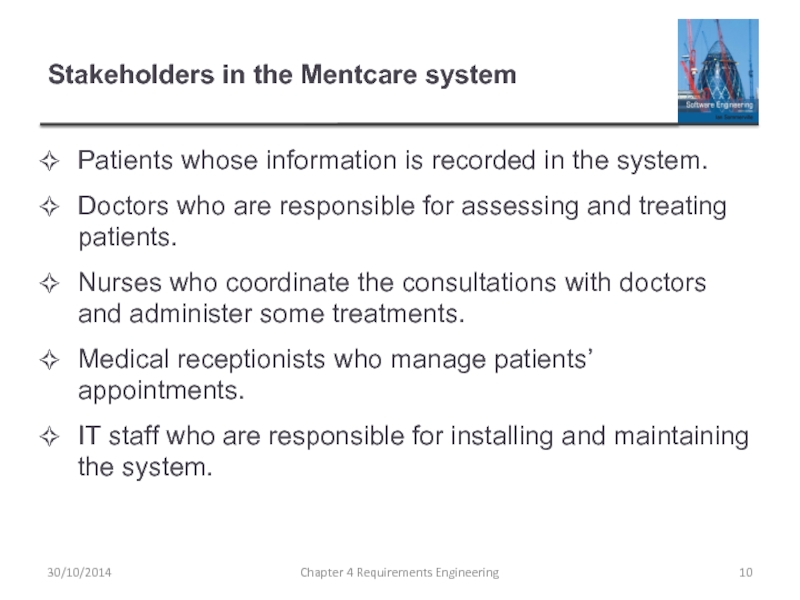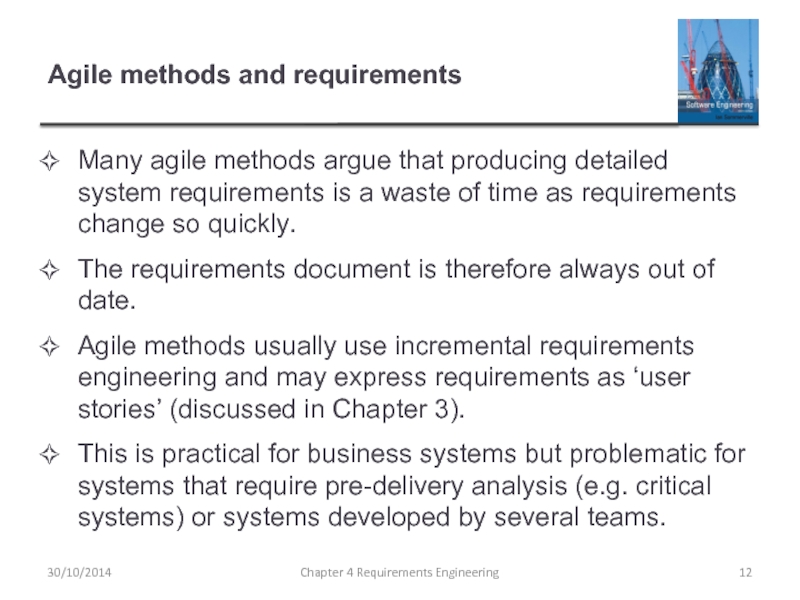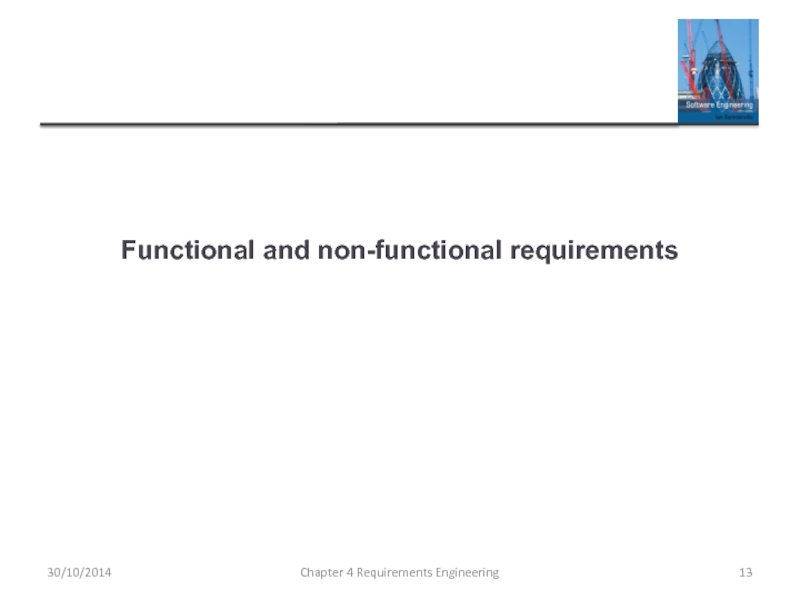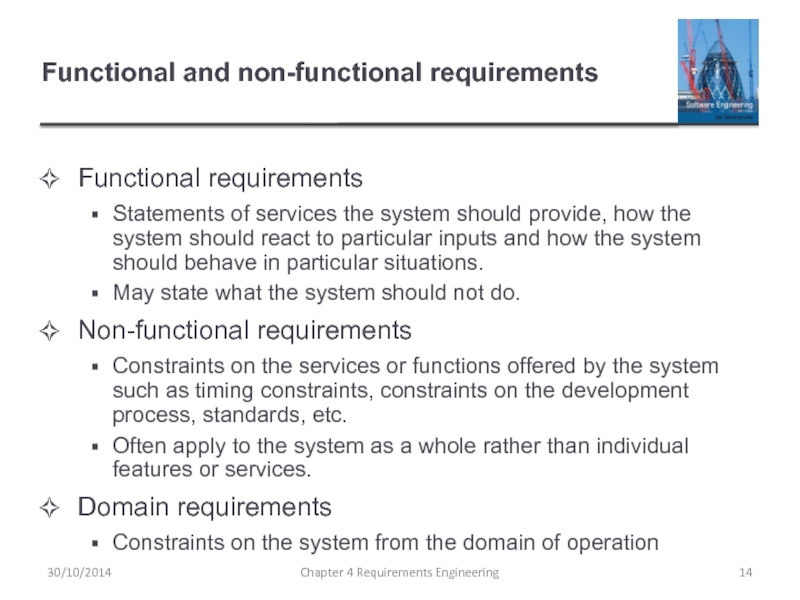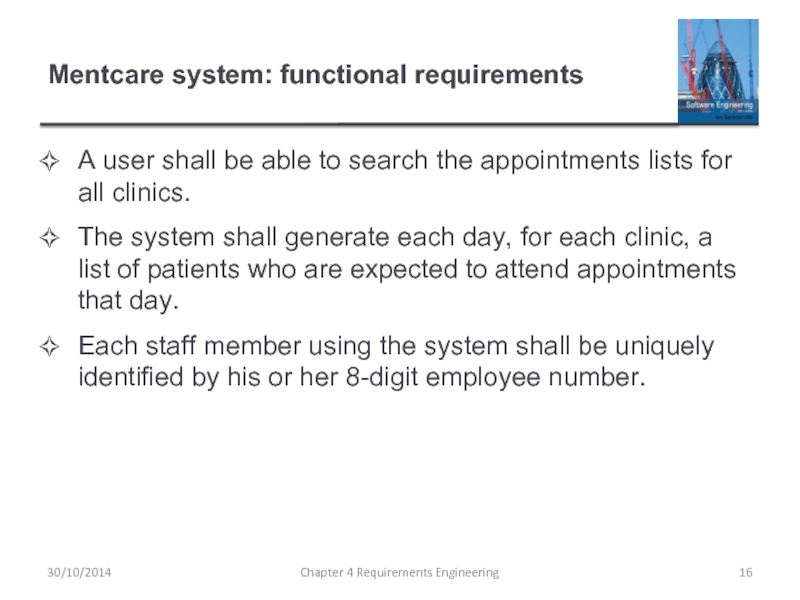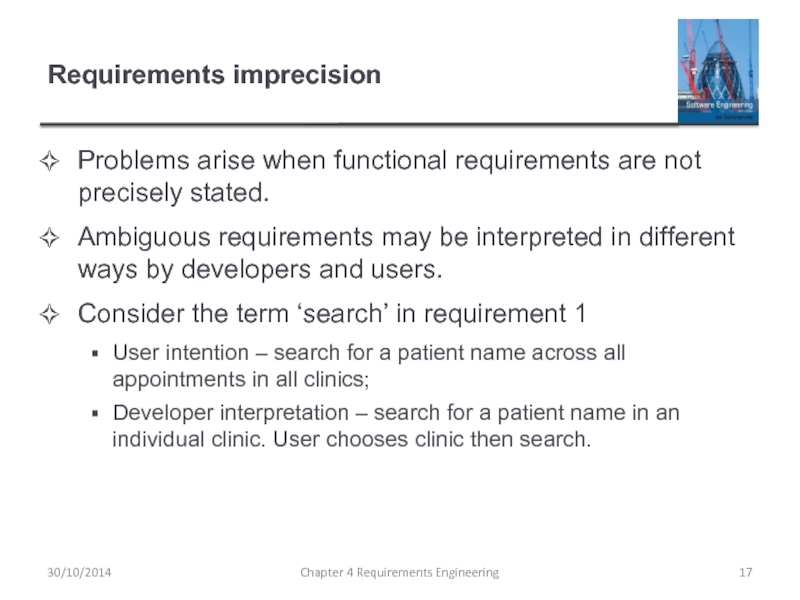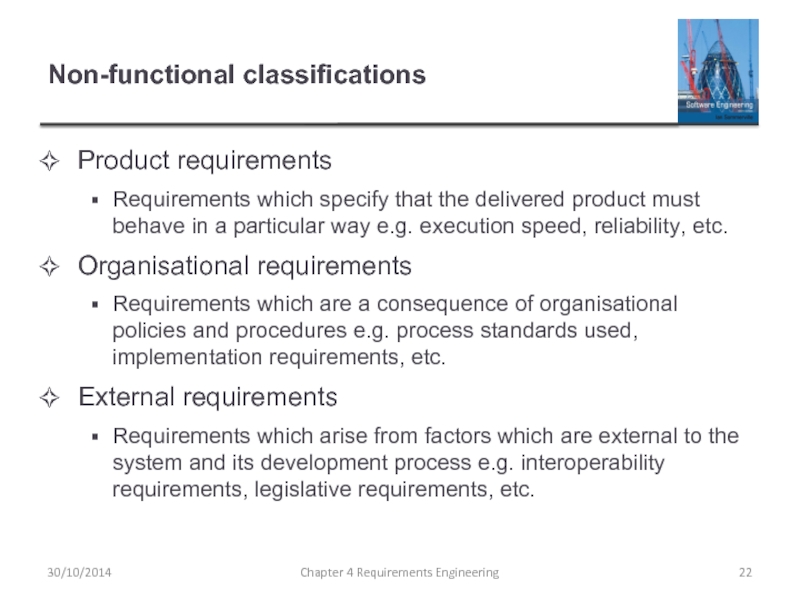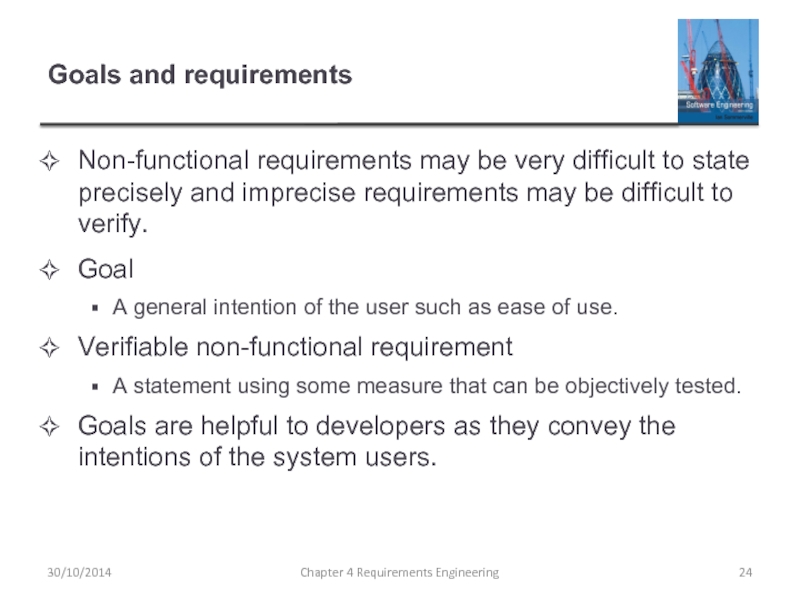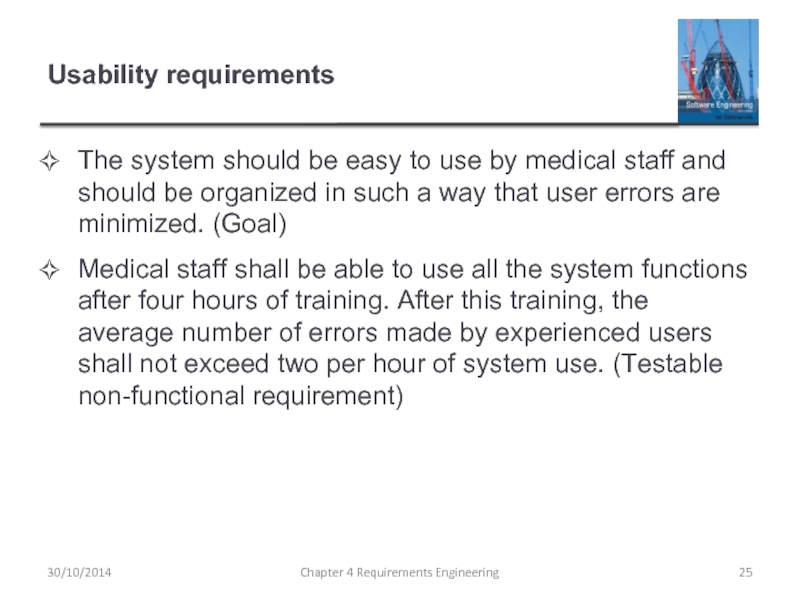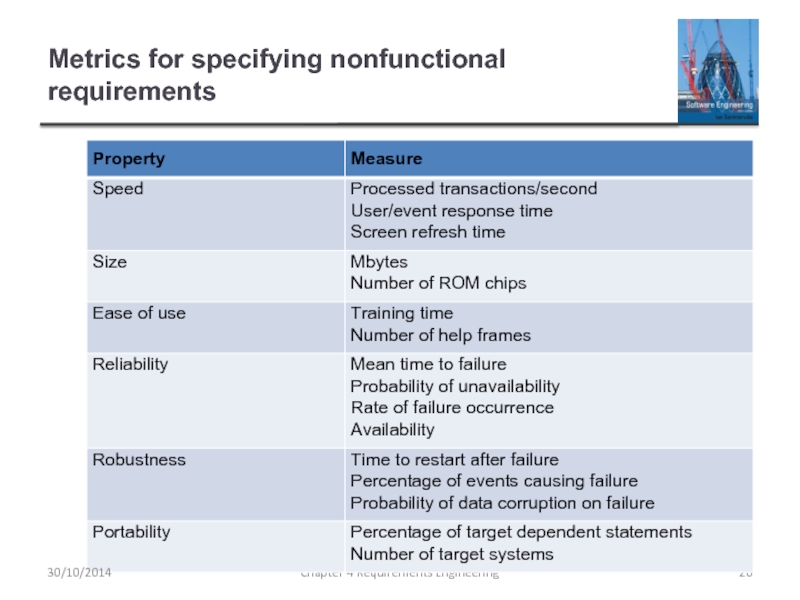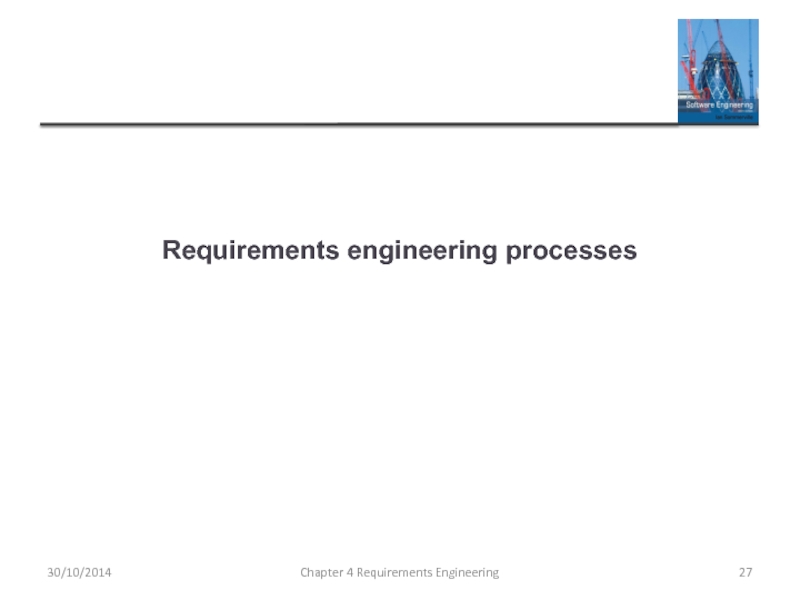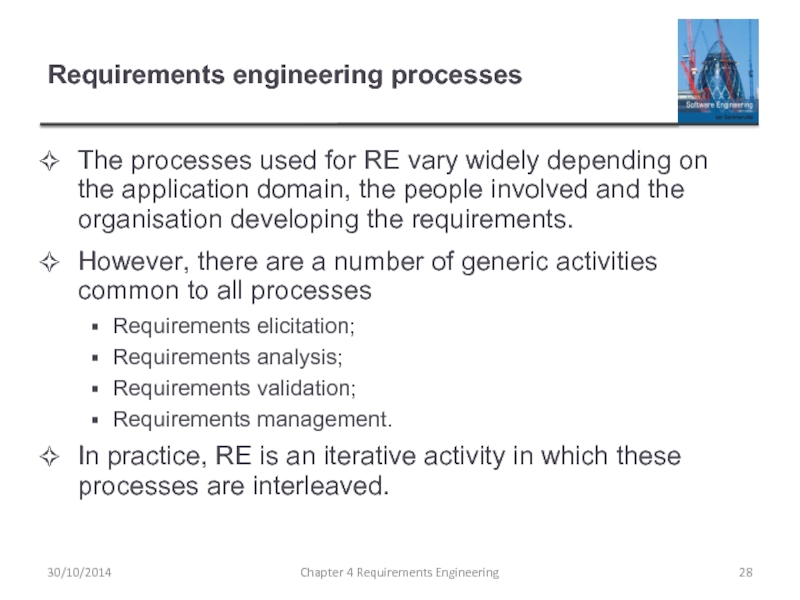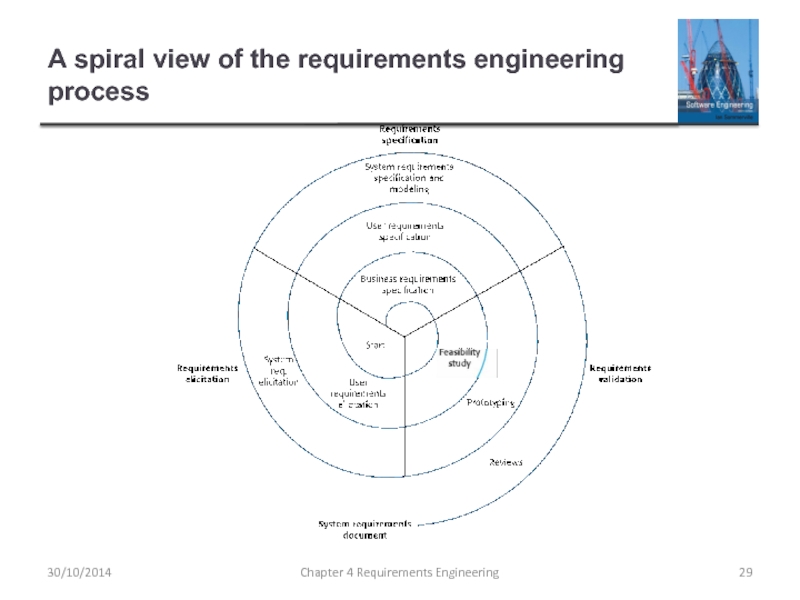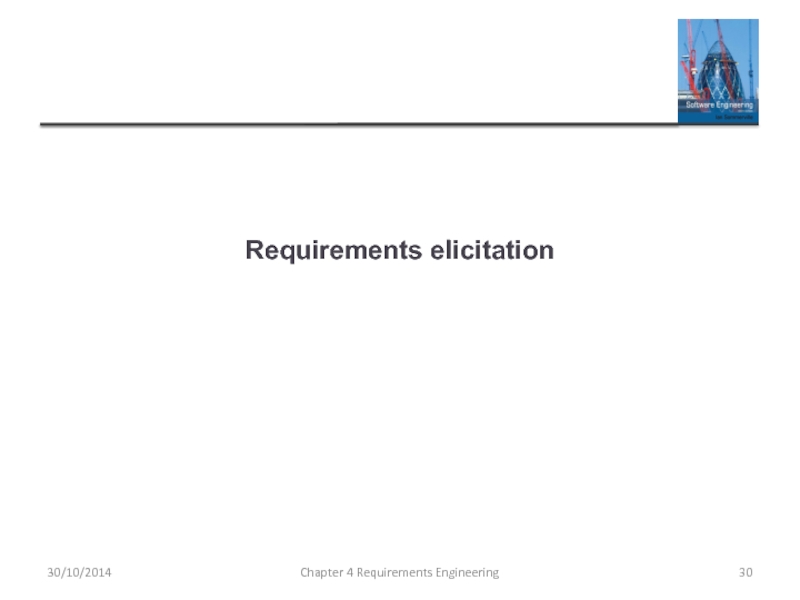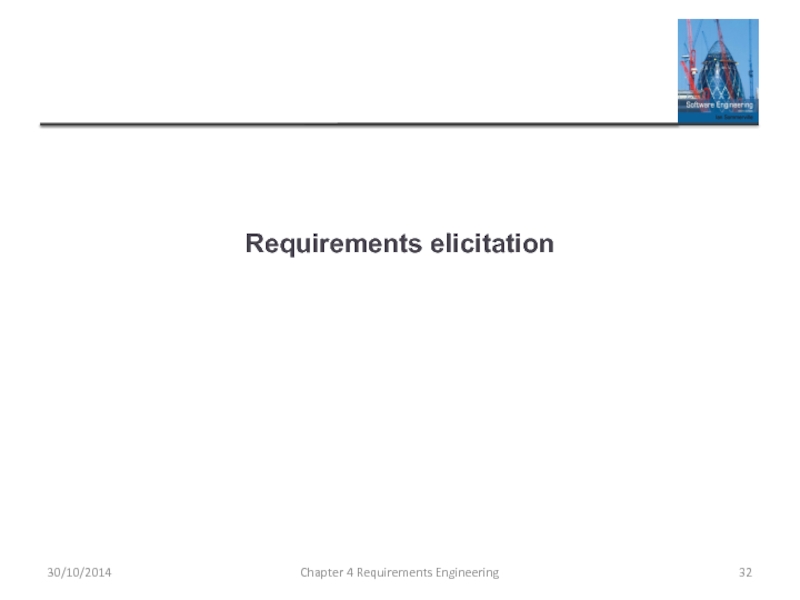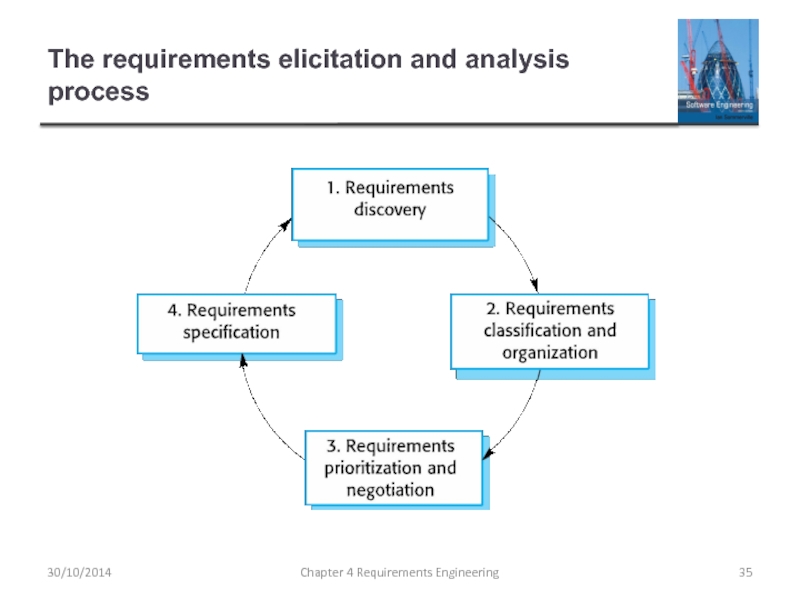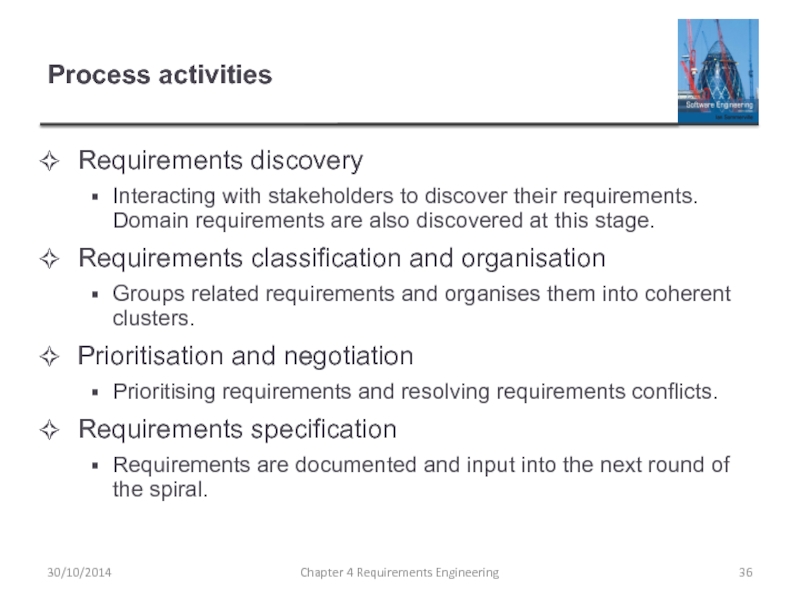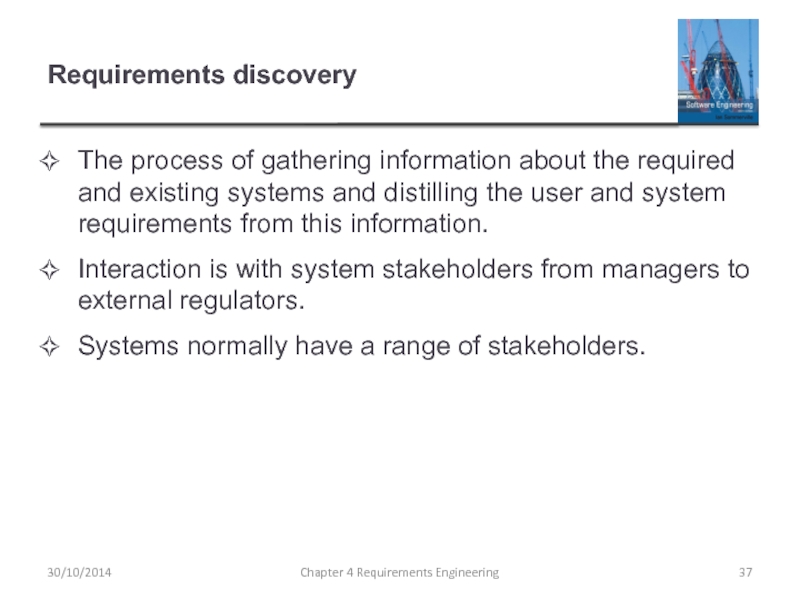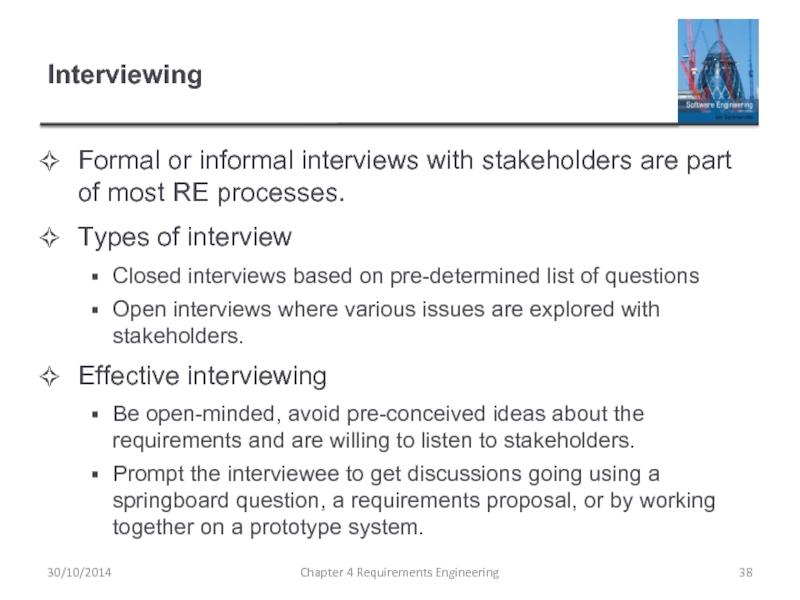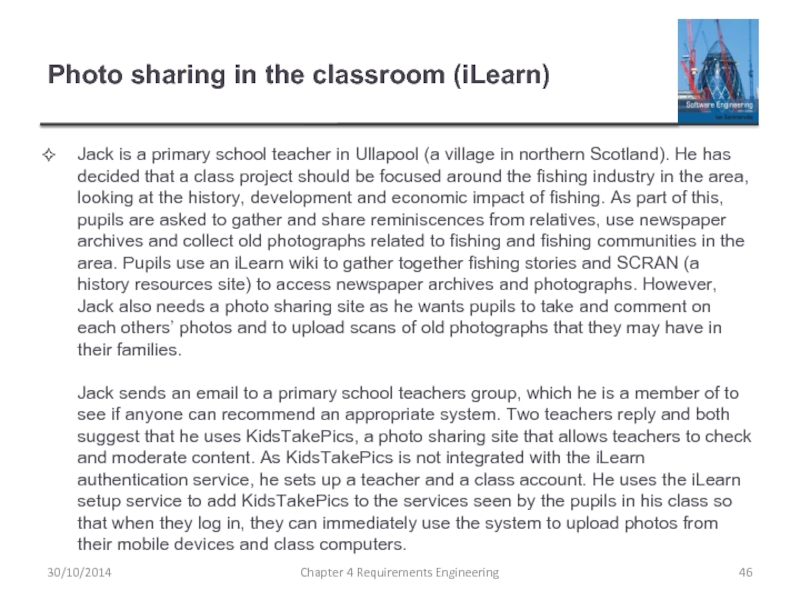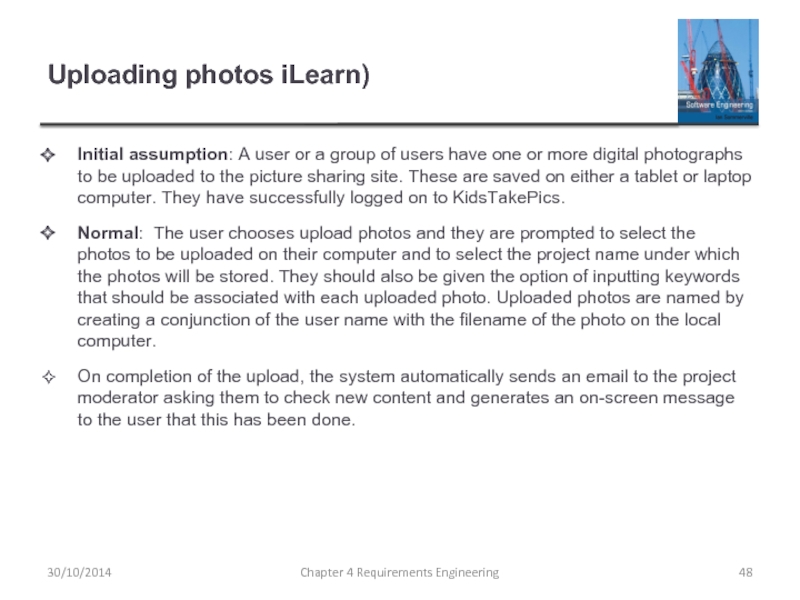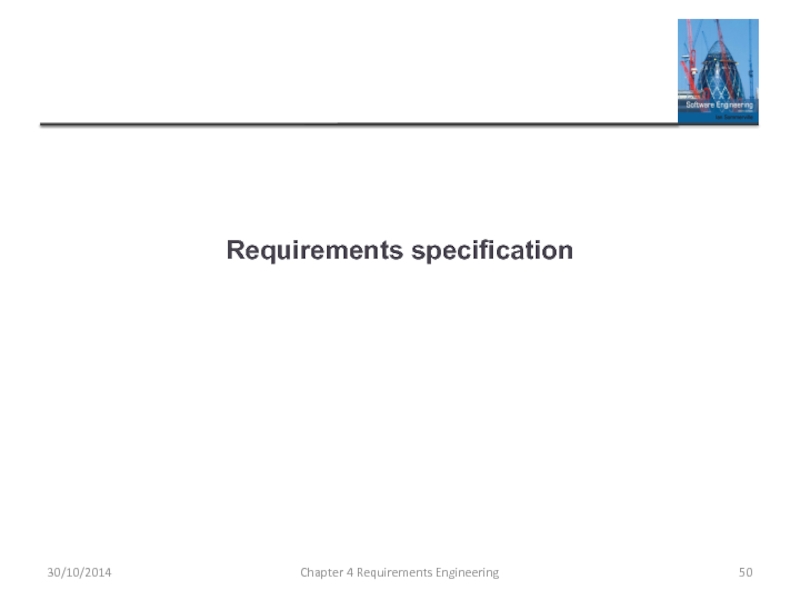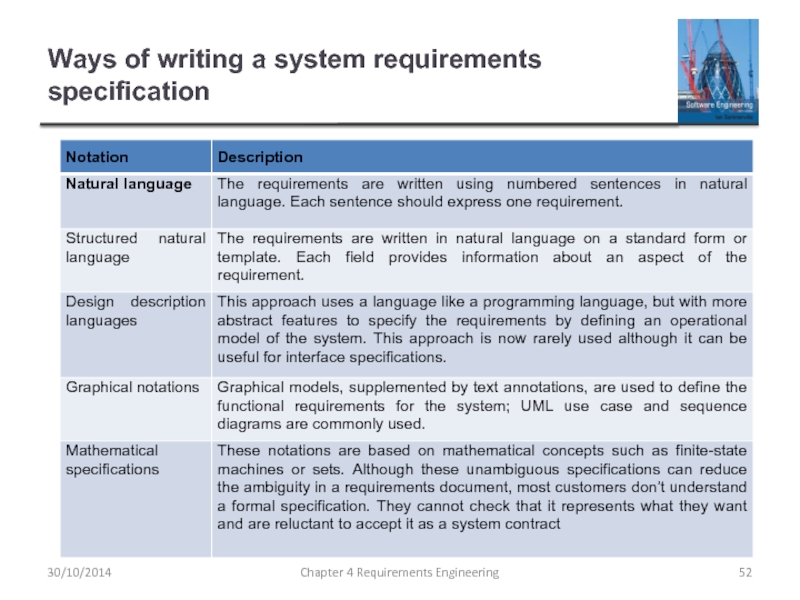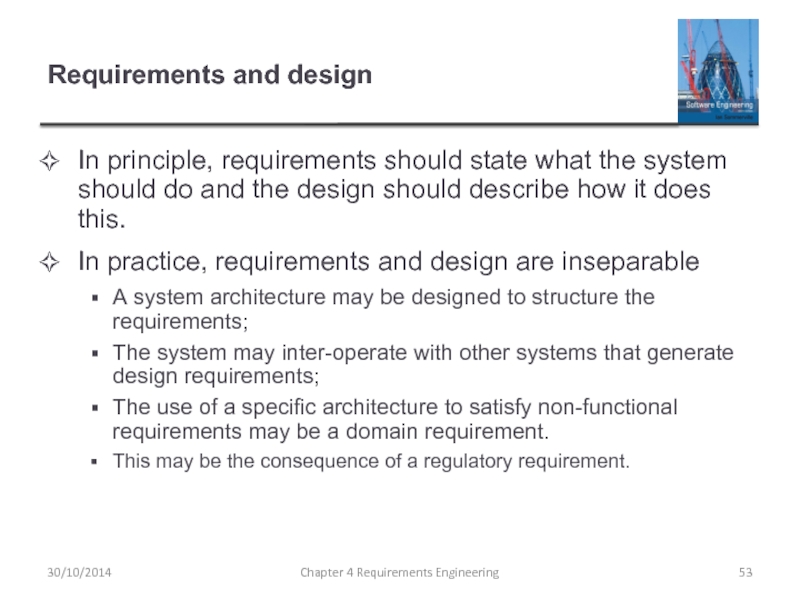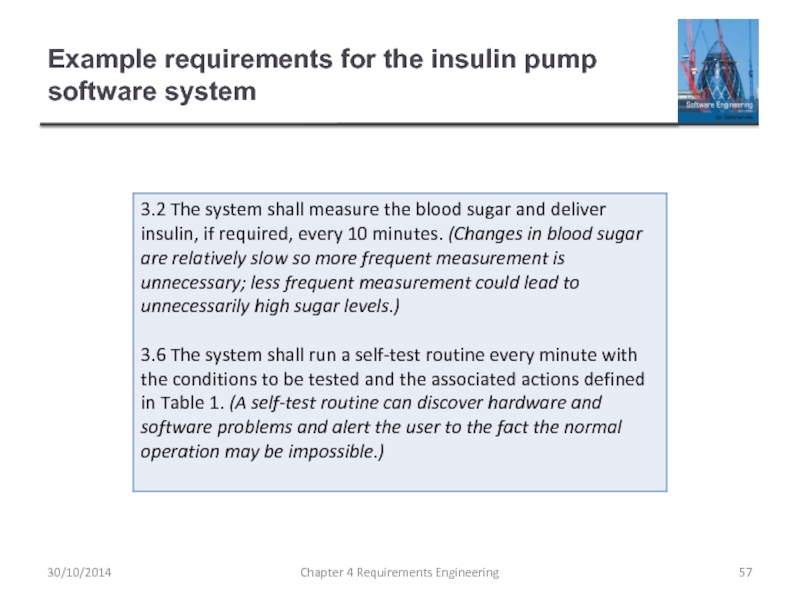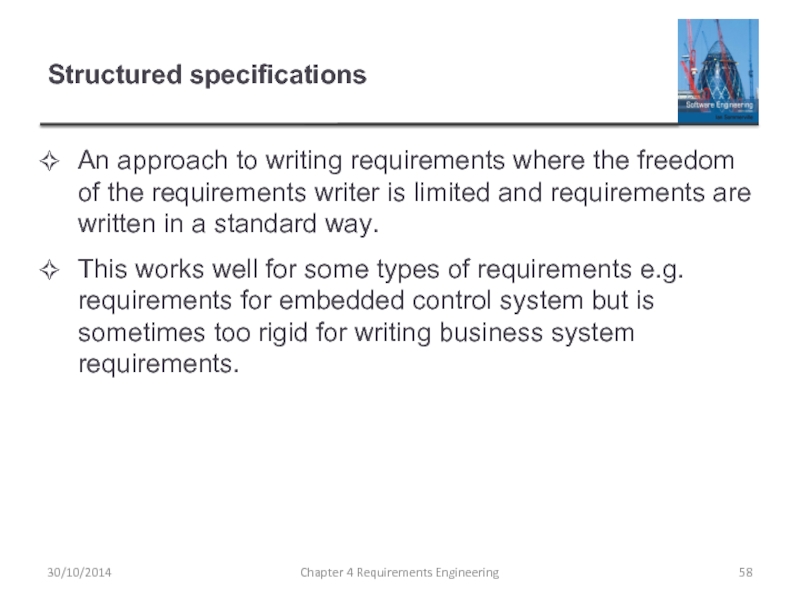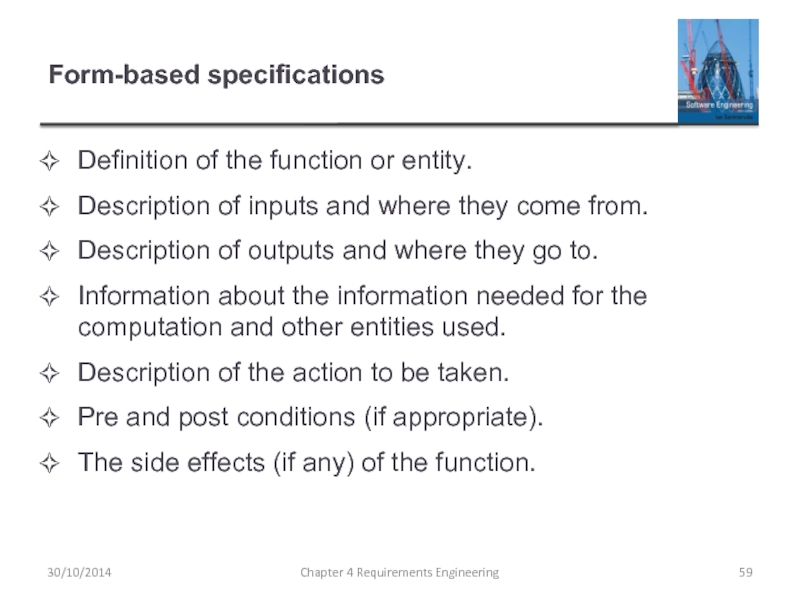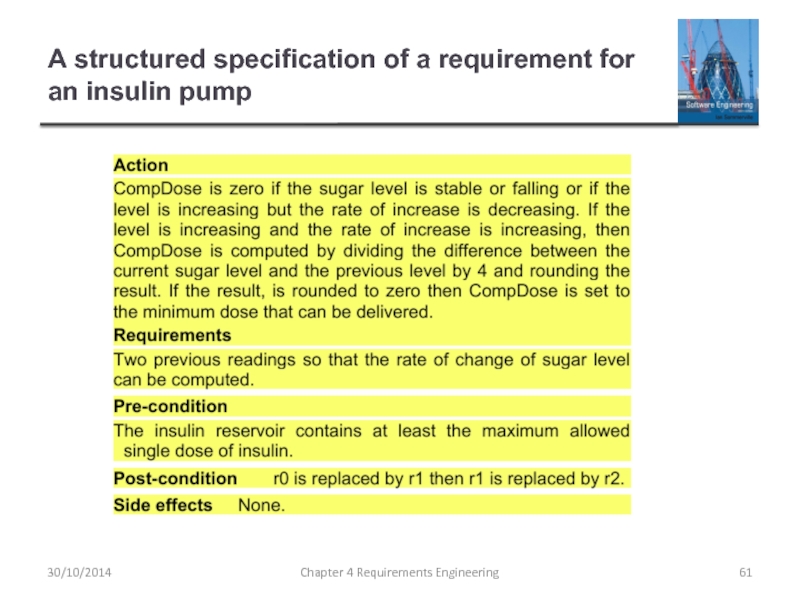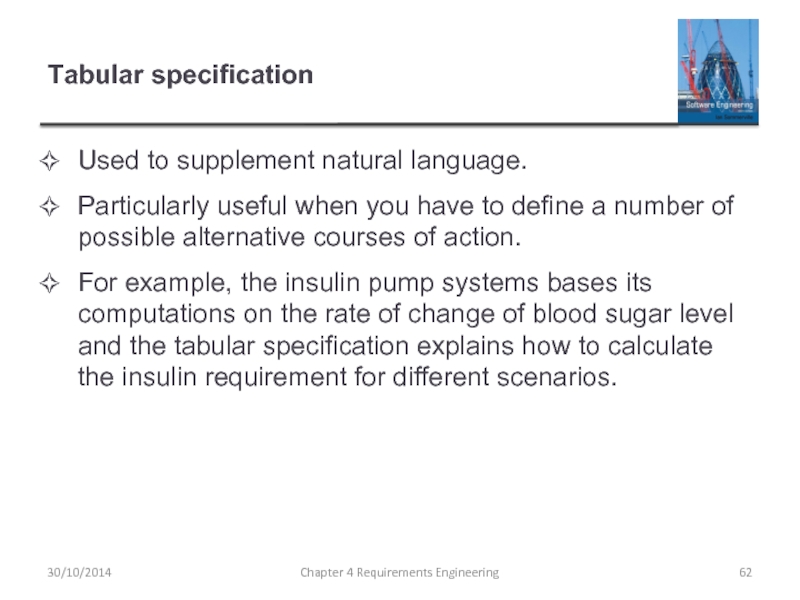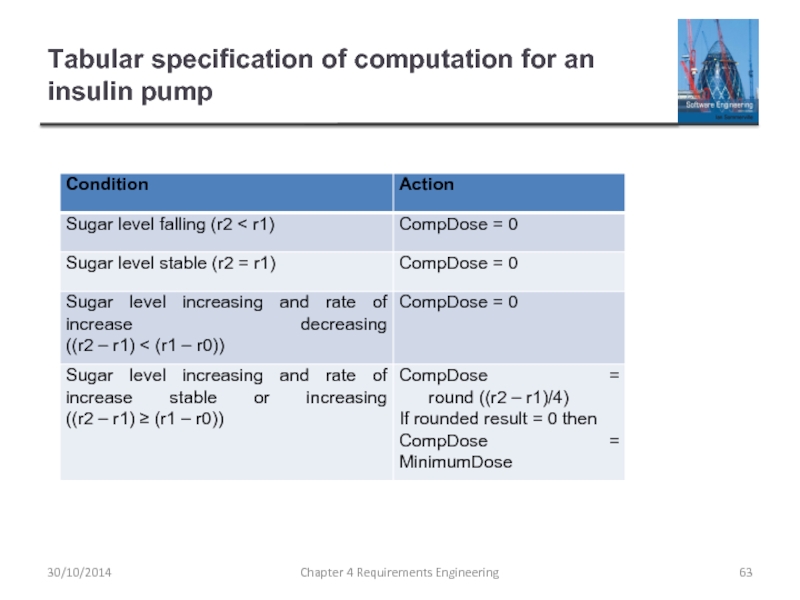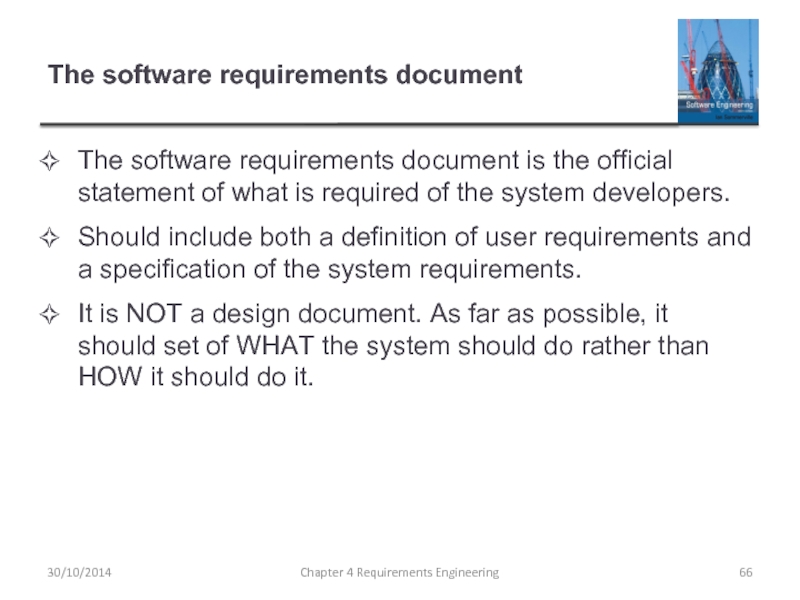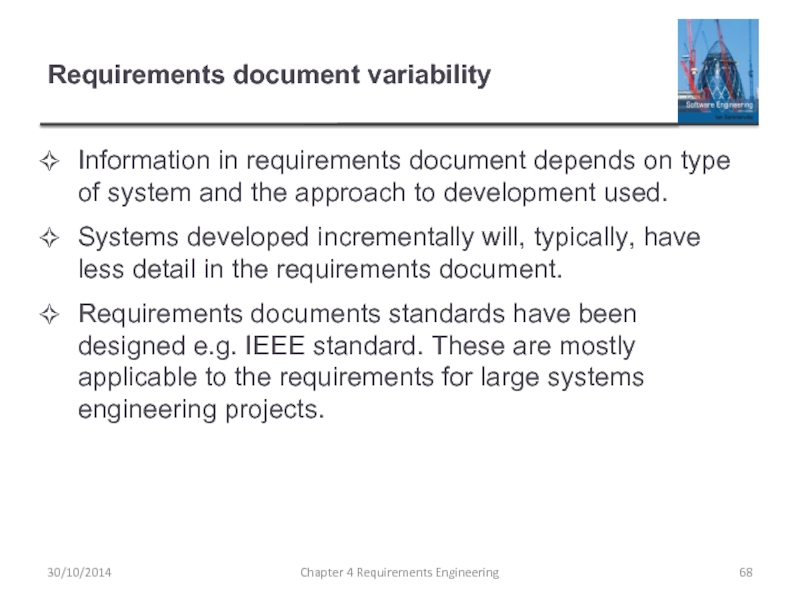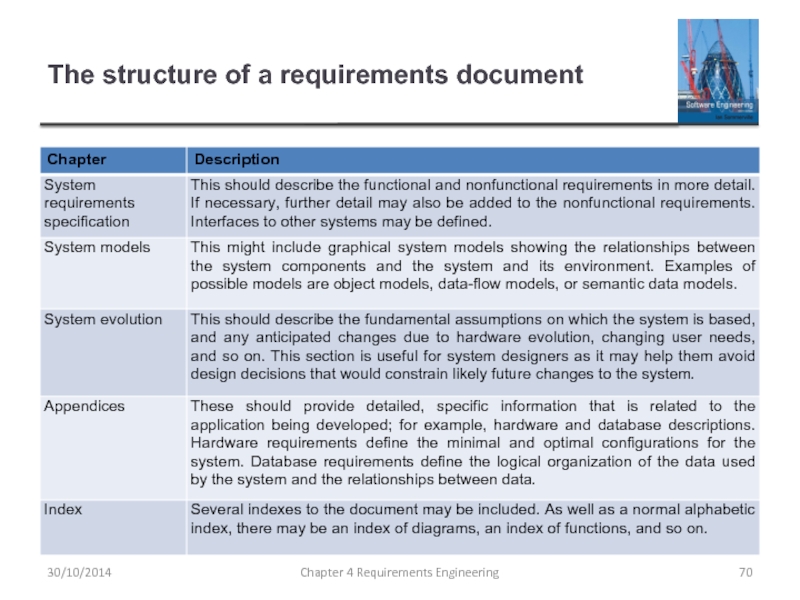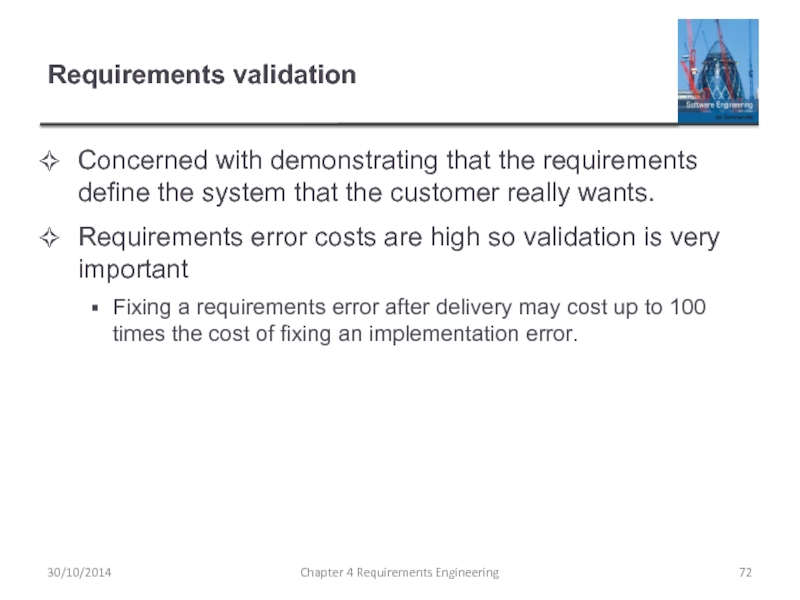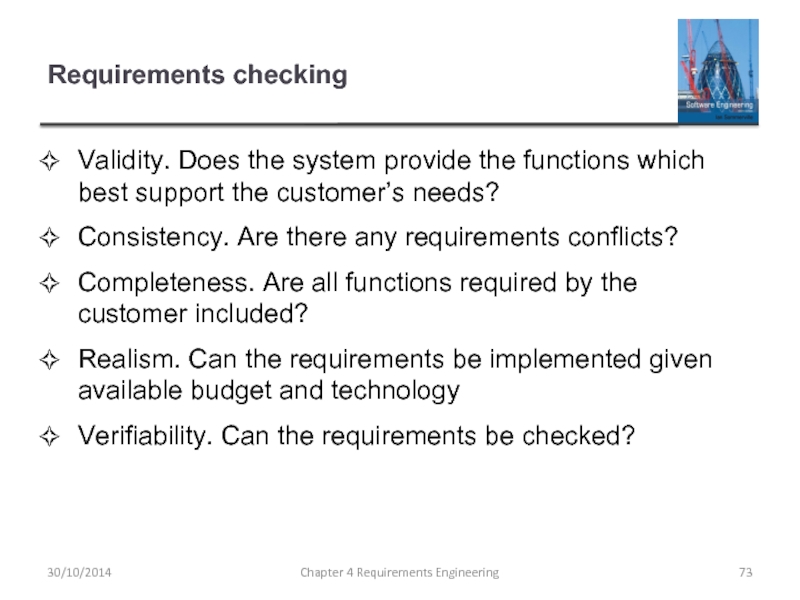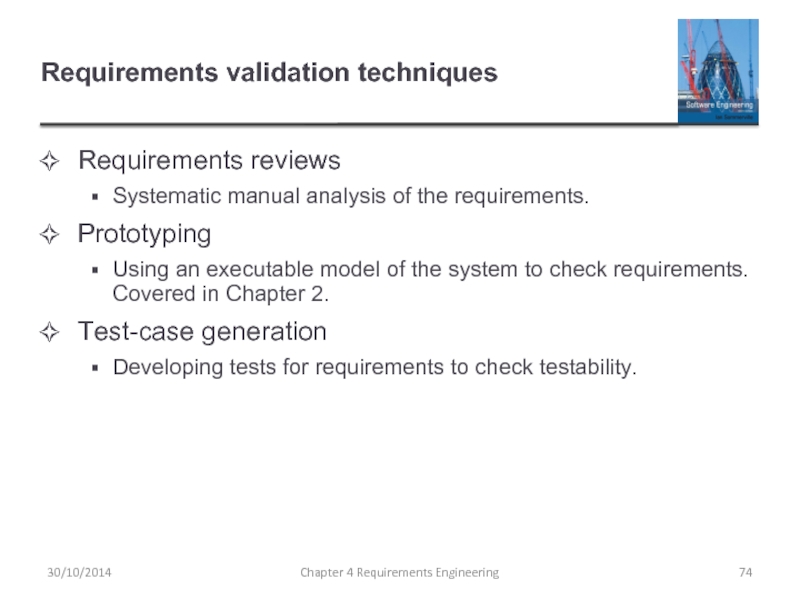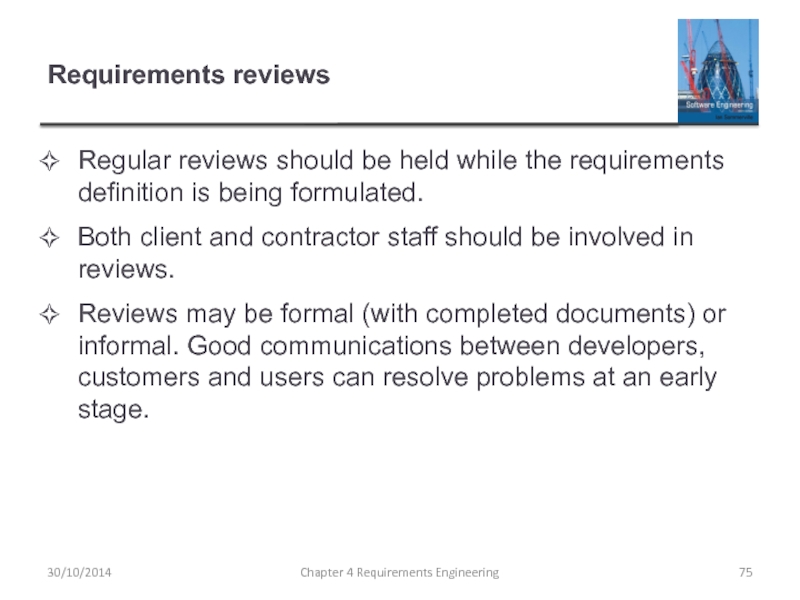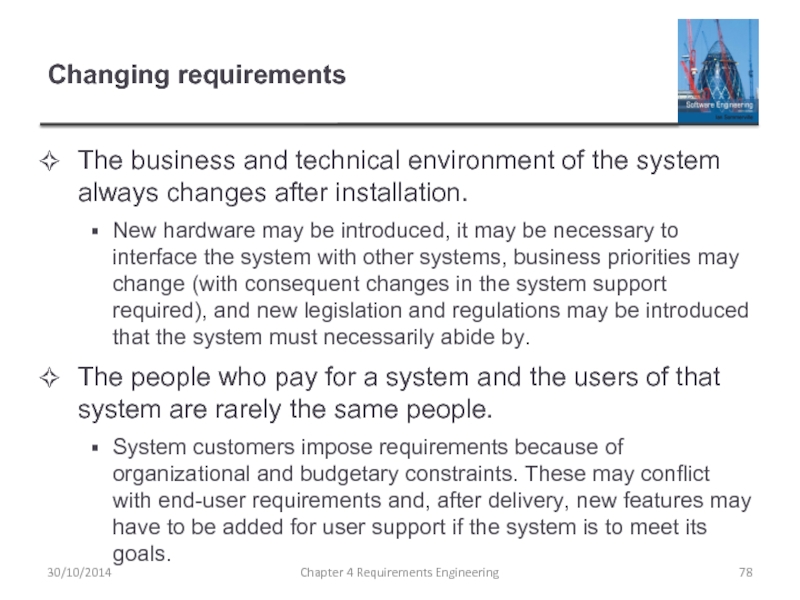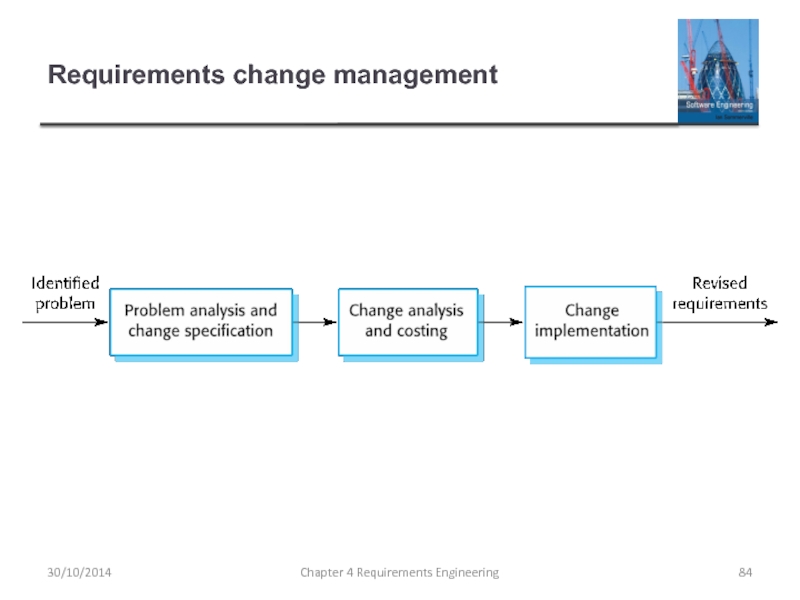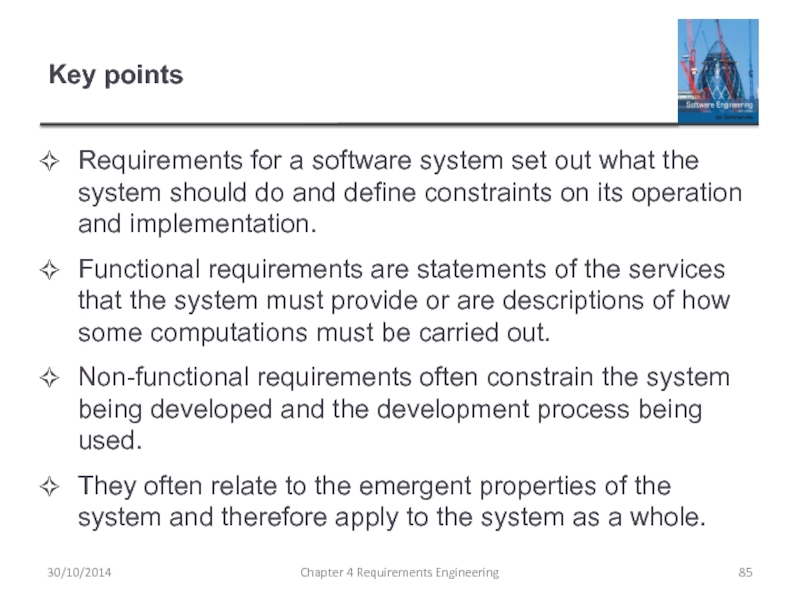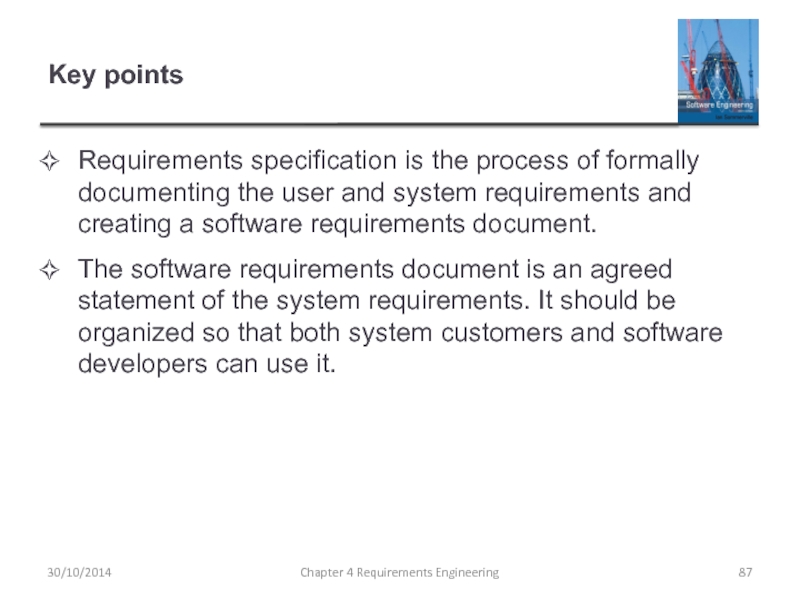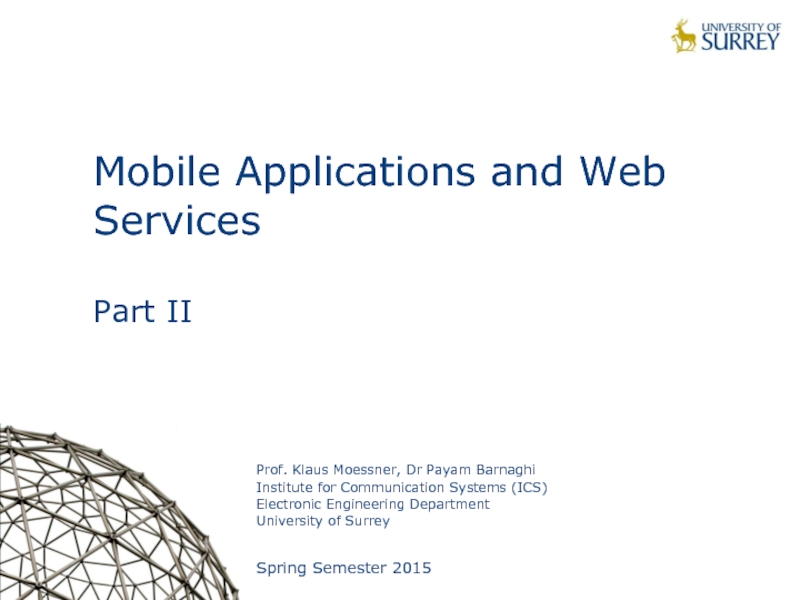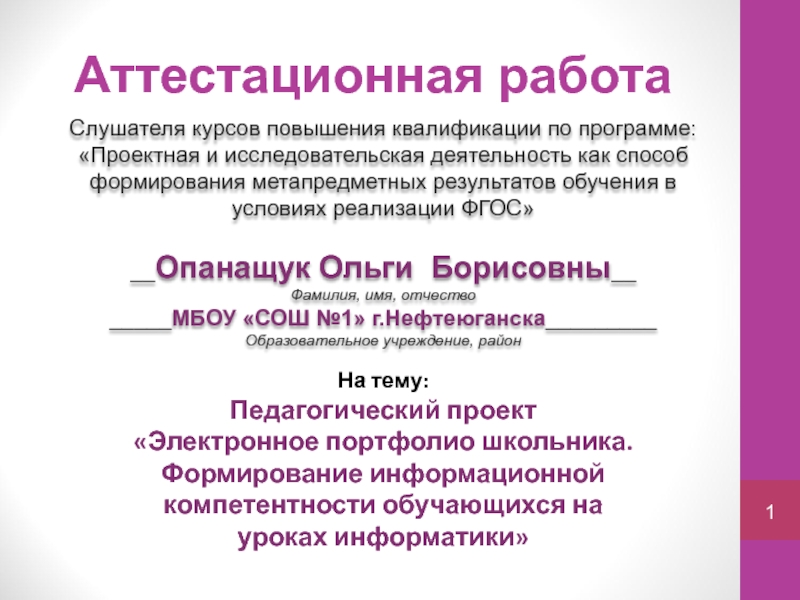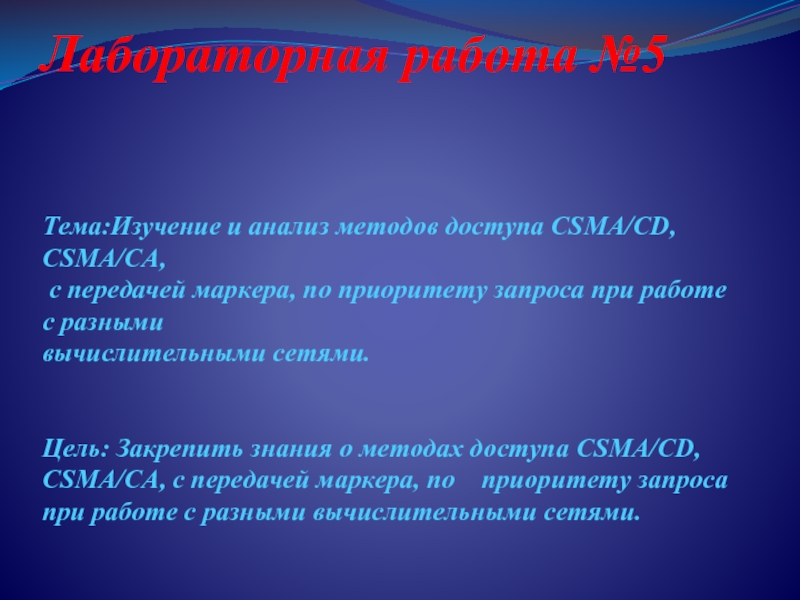- Главная
- Разное
- Дизайн
- Бизнес и предпринимательство
- Аналитика
- Образование
- Развлечения
- Красота и здоровье
- Финансы
- Государство
- Путешествия
- Спорт
- Недвижимость
- Армия
- Графика
- Культурология
- Еда и кулинария
- Лингвистика
- Английский язык
- Астрономия
- Алгебра
- Биология
- География
- Детские презентации
- Информатика
- История
- Литература
- Маркетинг
- Математика
- Медицина
- Менеджмент
- Музыка
- МХК
- Немецкий язык
- ОБЖ
- Обществознание
- Окружающий мир
- Педагогика
- Русский язык
- Технология
- Физика
- Философия
- Химия
- Шаблоны, картинки для презентаций
- Экология
- Экономика
- Юриспруденция
Requirements Engineering презентация
Содержание
- 1. Requirements Engineering
- 2. Topics covered Functional and non-functional requirements Requirements
- 3. Requirements engineering The process of establishing the
- 4. What is a requirement? It may range
- 5. Requirements abstraction (Davis) Chapter 4 Requirements Engineering
- 6. Types of requirement User requirements Statements in
- 7. User and system requirements Chapter 4 Requirements Engineering 30/10/2014
- 8. Readers of different types of requirements specification Chapter 4 Requirements Engineering 30/10/2014
- 9. System stakeholders Any person or organization who
- 10. Stakeholders in the Mentcare system Patients whose
- 11. Stakeholders in the Mentcare system A medical
- 12. Agile methods and requirements Many agile methods
- 13. Functional and non-functional requirements Chapter 4 Requirements Engineering 30/10/2014
- 14. Functional and non-functional requirements Functional requirements Statements
- 15. Functional requirements Describe functionality or system services.
- 16. Mentcare system: functional requirements A user shall
- 17. Requirements imprecision Problems arise when functional requirements
- 18. Requirements completeness and consistency In principle, requirements
- 19. Non-functional requirements These define system properties and
- 20. Types of nonfunctional requirement Chapter 4 Requirements Engineering 30/10/2014
- 21. Non-functional requirements implementation Non-functional requirements may affect
- 22. Non-functional classifications Product requirements Requirements which specify
- 23. Examples of nonfunctional requirements in the Mentcare system Chapter 4 Requirements Engineering 30/10/2014
- 24. Goals and requirements Non-functional requirements may be
- 25. Usability requirements The system should be easy
- 26. Metrics for specifying nonfunctional requirements Chapter 4 Requirements Engineering 30/10/2014
- 27. Requirements engineering processes Chapter 4 Requirements Engineering 30/10/2014
- 28. Requirements engineering processes The processes used for
- 29. A spiral view of the requirements engineering process Chapter 4 Requirements Engineering 30/10/2014
- 30. Requirements elicitation Chapter 4 Requirements Engineering 30/10/2014
- 31. Requirements elicitation and analysis Sometimes called requirements
- 32. Requirements elicitation Chapter 4 Requirements Engineering 30/10/2014
- 33. Requirements elicitation Software engineers work with a
- 34. Problems of requirements elicitation Stakeholders don’t know
- 35. The requirements elicitation and analysis process Chapter 4 Requirements Engineering 30/10/2014
- 36. Process activities Requirements discovery Interacting with stakeholders
- 37. Requirements discovery The process of gathering information
- 38. Interviewing Formal or informal interviews with stakeholders
- 39. Interviews in practice Normally a mix of
- 40. Problems with interviews Application specialists may use
- 41. Ethnography A social scientist spends a considerable
- 42. Scope of ethnography Requirements that are derived
- 43. Focused ethnography Developed in a project studying
- 44. Ethnography and prototyping for requirements analysis Chapter 4 Requirements Engineering 30/10/2014
- 45. Stories and scenarios Scenarios and user stories
- 46. Photo sharing in the classroom (iLearn) Jack
- 47. Scenarios A structured form of user story
- 48. Uploading photos iLearn) Initial assumption: A user
- 49. Uploading photos What can go wrong:
- 50. Requirements specification Chapter 4 Requirements Engineering 30/10/2014
- 51. Requirements specification The process of writing donw
- 52. Ways of writing a system requirements specification Chapter 4 Requirements Engineering 30/10/2014
- 53. Requirements and design In principle, requirements should
- 54. Natural language specification Requirements are written as
- 55. Guidelines for writing requirements Invent a standard
- 56. Problems with natural language Lack of clarity
- 57. Example requirements for the insulin pump software system Chapter 4 Requirements Engineering 30/10/2014
- 58. Structured specifications An approach to writing requirements
- 59. Form-based specifications Definition of the function or
- 60. A structured specification of a requirement for
- 61. A structured specification of a requirement for
- 62. Tabular specification Used to supplement natural language.
- 63. Tabular specification of computation for an insulin pump Chapter 4 Requirements Engineering 30/10/2014
- 64. Use cases Use-cases are a kind of
- 65. Use cases for the Mentcare system Chapter 4 Requirements Engineering 30/10/2014
- 66. The software requirements document The software requirements
- 67. Users of a requirements document Chapter 4 Requirements Engineering 30/10/2014
- 68. Requirements document variability Information in requirements document
- 69. The structure of a requirements document Chapter 4 Requirements Engineering 30/10/2014
- 70. The structure of a requirements document Chapter 4 Requirements Engineering 30/10/2014
- 71. Requirements validation Chapter 4 Requirements Engineering 30/10/2014
- 72. Requirements validation Concerned with demonstrating that the
- 73. Requirements checking Validity. Does the system provide
- 74. Requirements validation techniques Requirements reviews Systematic manual
- 75. Requirements reviews Regular reviews should be held
- 76. Review checks Verifiability Is the requirement realistically
- 77. Requirements change Chapter 4 Requirements Engineering 30/10/2014
- 78. Changing requirements The business and technical environment
- 79. Changing requirements Large systems usually have a
- 80. Requirements evolution Chapter 4 Requirements Engineering 30/10/2014
- 81. Requirements management Requirements management is the process
- 82. Requirements management planning Establishes the level of
- 83. Requirements change management Deciding if a requirements
- 84. Requirements change management Chapter 4 Requirements Engineering 30/10/2014
- 85. Key points Requirements for a software system
- 86. Key points The requirements engineering process is
- 87. Key points Requirements specification is the process
- 88. Key points Requirements validation is the process
Слайд 2Topics covered
Functional and non-functional requirements
Requirements engineering processes
Requirements elicitation
Requirements specification
Requirements validation
Requirements change
Chapter
30/10/2014
Слайд 3Requirements engineering
The process of establishing the services that acustomer requires from
The system requirements are the descriptions of the system services and constraints that are generated during the requirements engineering process.
Chapter 4 Requirements Engineering
30/10/2014
Слайд 4What is a requirement?
It may range from a high-level abstract statement
This is inevitable as requirements may serve a dual function
May be the basis for a bid for a contract - therefore must be open to interpretation;
May be the basis for the contract itself - therefore must be defined in detail;
Both these statements may be called requirements.
Chapter 4 Requirements Engineering
30/10/2014
Слайд 5Requirements abstraction (Davis)
Chapter 4 Requirements Engineering
“If a company wishes to let
30/10/2014
Слайд 6Types of requirement
User requirements
Statements in natural language plus diagrams of the
System requirements
A structured document setting out detailed descriptions of the system’s functions, services and operational constraints. Defines what should be implemented so may be part of a contract between client and contractor.
Chapter 4 Requirements Engineering
30/10/2014
Слайд 8Readers of different types of requirements specification
Chapter 4 Requirements Engineering
30/10/2014
Слайд 9System stakeholders
Any person or organization who is affected by the system
Stakeholder types
End users
System managers
System owners
External stakeholders
Chapter 4 Requirements Engineering
30/10/2014
Слайд 10Stakeholders in the Mentcare system
Patients whose information is recorded in the
Doctors who are responsible for assessing and treating patients.
Nurses who coordinate the consultations with doctors and administer some treatments.
Medical receptionists who manage patients’ appointments.
IT staff who are responsible for installing and maintaining the system.
Chapter 4 Requirements Engineering
30/10/2014
Слайд 11Stakeholders in the Mentcare system
A medical ethics manager who must ensure
Health care managers who obtain management information from the system.
Medical records staff who are responsible for ensuring that system information can be maintained and preserved, and that record keeping procedures have been properly implemented.
Chapter 4 Requirements Engineering
30/10/2014
Слайд 12Agile methods and requirements
Many agile methods argue that producing detailed system
The requirements document is therefore always out of date.
Agile methods usually use incremental requirements engineering and may express requirements as ‘user stories’ (discussed in Chapter 3).
This is practical for business systems but problematic for systems that require pre-delivery analysis (e.g. critical systems) or systems developed by several teams.
Chapter 4 Requirements Engineering
30/10/2014
Слайд 14Functional and non-functional requirements
Functional requirements
Statements of services the system should provide,
May state what the system should not do.
Non-functional requirements
Constraints on the services or functions offered by the system such as timing constraints, constraints on the development process, standards, etc.
Often apply to the system as a whole rather than individual features or services.
Domain requirements
Constraints on the system from the domain of operation
Chapter 4 Requirements Engineering
30/10/2014
Слайд 15Functional requirements
Describe functionality or system services.
Depend on the type of software,
Functional user requirements may be high-level statements of what the system should do.
Functional system requirements should describe the system services in detail.
Chapter 4 Requirements Engineering
30/10/2014
Слайд 16Mentcare system: functional requirements
A user shall be able to search the
The system shall generate each day, for each clinic, a list of patients who are expected to attend appointments that day.
Each staff member using the system shall be uniquely identified by his or her 8-digit employee number.
Chapter 4 Requirements Engineering
30/10/2014
Слайд 17Requirements imprecision
Problems arise when functional requirements are not precisely stated.
Ambiguous requirements
Consider the term ‘search’ in requirement 1
User intention – search for a patient name across all appointments in all clinics;
Developer interpretation – search for a patient name in an individual clinic. User chooses clinic then search.
Chapter 4 Requirements Engineering
30/10/2014
Слайд 18Requirements completeness and consistency
In principle, requirements should be both complete and
Complete
They should include descriptions of all facilities required.
Consistent
There should be no conflicts or contradictions in the descriptions of the system facilities.
In practice, because of system and environmental complexity, it is impossible to produce a complete and consistent requirements document.
Chapter 4 Requirements Engineering
30/10/2014
Слайд 19Non-functional requirements
These define system properties and constraints e.g. reliability, response time
Process requirements may also be specified mandating a particular IDE, programming language or development method.
Non-functional requirements may be more critical than functional requirements. If these are not met, the system may be useless.
Chapter 4 Requirements Engineering
30/10/2014
Слайд 21Non-functional requirements implementation
Non-functional requirements may affect the overall architecture of a
For example, to ensure that performance requirements are met, you may have to organize the system to minimize communications between components.
A single non-functional requirement, such as a security requirement, may generate a number of related functional requirements that define system services that are required.
It may also generate requirements that restrict existing requirements.
Chapter 4 Requirements Engineering
30/10/2014
Слайд 22Non-functional classifications
Product requirements
Requirements which specify that the delivered product must behave
Organisational requirements
Requirements which are a consequence of organisational policies and procedures e.g. process standards used, implementation requirements, etc.
External requirements
Requirements which arise from factors which are external to the system and its development process e.g. interoperability requirements, legislative requirements, etc.
Chapter 4 Requirements Engineering
30/10/2014
Слайд 23Examples of nonfunctional requirements in the Mentcare system
Chapter 4 Requirements Engineering
30/10/2014
Слайд 24Goals and requirements
Non-functional requirements may be very difficult to state precisely
Goal
A general intention of the user such as ease of use.
Verifiable non-functional requirement
A statement using some measure that can be objectively tested.
Goals are helpful to developers as they convey the intentions of the system users.
Chapter 4 Requirements Engineering
30/10/2014
Слайд 25Usability requirements
The system should be easy to use by medical staff
Medical staff shall be able to use all the system functions after four hours of training. After this training, the average number of errors made by experienced users shall not exceed two per hour of system use. (Testable non-functional requirement)
Chapter 4 Requirements Engineering
30/10/2014
Слайд 26Metrics for specifying nonfunctional requirements
Chapter 4 Requirements Engineering
30/10/2014
Слайд 28Requirements engineering processes
The processes used for RE vary widely depending on
However, there are a number of generic activities common to all processes
Requirements elicitation;
Requirements analysis;
Requirements validation;
Requirements management.
In practice, RE is an iterative activity in which these processes are interleaved.
Chapter 4 Requirements Engineering
30/10/2014
Слайд 29A spiral view of the requirements engineering process
Chapter 4 Requirements
30/10/2014
Слайд 31Requirements elicitation and analysis
Sometimes called requirements elicitation or requirements discovery.
Involves technical
May involve end-users, managers, engineers involved in maintenance, domain experts, trade unions, etc. These are called stakeholders.
Chapter 4 Requirements Engineering
30/10/2014
Слайд 33Requirements elicitation
Software engineers work with a range of system stakeholders to
Stages include:
Requirements discovery,
Requirements classification and organization,
Requirements prioritization and negotiation,
Requirements specification.
Chapter 4 Requirements Engineering
30/10/2014
Слайд 34Problems of requirements elicitation
Stakeholders don’t know what they really want.
Stakeholders express
Different stakeholders may have conflicting requirements.
Organisational and political factors may influence the system requirements.
The requirements change during the analysis process. New stakeholders may emerge and the business environment may change.
Chapter 4 Requirements Engineering
30/10/2014
Слайд 35The requirements elicitation and analysis process
Chapter 4 Requirements Engineering
30/10/2014
Слайд 36Process activities
Requirements discovery
Interacting with stakeholders to discover their requirements. Domain requirements
Requirements classification and organisation
Groups related requirements and organises them into coherent clusters.
Prioritisation and negotiation
Prioritising requirements and resolving requirements conflicts.
Requirements specification
Requirements are documented and input into the next round of the spiral.
30/10/2014
Chapter 4 Requirements Engineering
Слайд 37Requirements discovery
The process of gathering information about the required and existing
Interaction is with system stakeholders from managers to external regulators.
Systems normally have a range of stakeholders.
Chapter 4 Requirements Engineering
30/10/2014
Слайд 38Interviewing
Formal or informal interviews with stakeholders are part of most RE
Types of interview
Closed interviews based on pre-determined list of questions
Open interviews where various issues are explored with stakeholders.
Effective interviewing
Be open-minded, avoid pre-conceived ideas about the requirements and are willing to listen to stakeholders.
Prompt the interviewee to get discussions going using a springboard question, a requirements proposal, or by working together on a prototype system.
Chapter 4 Requirements Engineering
30/10/2014
Слайд 39Interviews in practice
Normally a mix of closed and open-ended interviewing.
Interviews are
Interviewers need to be open-minded without pre-conceived ideas of what the system should do
You need to prompt the use to talk about the system by suggesting requirements rather than simply asking them what they want.
30/10/2014
Chapter 4 Requirements Engineering
Слайд 40Problems with interviews
Application specialists may use language to describe their work
Interviews are not good for understanding domain requirements
Requirements engineers cannot understand specific domain terminology;
Some domain knowledge is so familiar that people find it hard to articulate or think that it isn’t worth articulating.
Chapter 4 Requirements Engineering
30/10/2014
Слайд 41Ethnography
A social scientist spends a considerable time observing and analysing how
People do not have to explain or articulate their work.
Social and organisational factors of importance may be observed.
Ethnographic studies have shown that work is usually richer and more complex than suggested by simple system models.
Chapter 4 Requirements Engineering
30/10/2014
Слайд 42Scope of ethnography
Requirements that are derived from the way that people
Requirements that are derived from cooperation and awareness of other people’s activities.
Awareness of what other people are doing leads to changes in the ways in which we do things.
Ethnography is effective for understanding existing processes but cannot identify new features that should be added to a system.
Chapter 4 Requirements Engineering
30/10/2014
Слайд 43Focused ethnography
Developed in a project studying the air traffic control process
Combines
Prototype development results in unanswered questions which focus the ethnographic analysis.
The problem with ethnography is that it studies existing practices which may have some historical basis which is no longer relevant.
Chapter 4 Requirements Engineering
30/10/2014
Слайд 44Ethnography and prototyping for requirements analysis
Chapter 4 Requirements Engineering
30/10/2014
Слайд 45Stories and scenarios
Scenarios and user stories are real-life examples of how
Stories and scenarios are a description of how a system may be used for a particular task.
Because they are based on a practical situation, stakeholders can relate to them and can comment on their situation with respect to the story.
30/10/2014
Chapter 4 Requirements Engineering
Слайд 46Photo sharing in the classroom (iLearn)
Jack is a primary school teacher
Chapter 4 Requirements Engineering
30/10/2014
Слайд 47Scenarios
A structured form of user story
Scenarios should include
A description of the
A description of the normal flow of events;
A description of what can go wrong;
Information about other concurrent activities;
A description of the state when the scenario finishes.
Chapter 4 Requirements Engineering
30/10/2014
Слайд 48Uploading photos iLearn)
Initial assumption: A user or a group of users
Normal: The user chooses upload photos and they are prompted to select the photos to be uploaded on their computer and to select the project name under which the photos will be stored. They should also be given the option of inputting keywords that should be associated with each uploaded photo. Uploaded photos are named by creating a conjunction of the user name with the filename of the photo on the local computer.
On completion of the upload, the system automatically sends an email to the project moderator asking them to check new content and generates an on-screen message to the user that this has been done.
Chapter 4 Requirements Engineering
30/10/2014
Слайд 49Uploading photos
What can go wrong:
No moderator is associated with the
Photos with the same name have already been uploaded by the same user. The user should be asked if they wish to re-upload the photos with the same name, rename the photos or cancel the upload. If they chose to re-upload the photos, the originals are overwritten. If they chose to rename the photos, a new name is automatically generated by adding a number to the existing file name.
Other activities: The moderator may be logged on to the system and may approve photos as they are uploaded.
System state on completion: User is logged on. The selected photos have been uploaded and assigned a status ‘awaiting moderation’. Photos are visible to the moderator and to the user who uploaded them.
Chapter 4 Requirements Engineering
30/10/2014
Слайд 51Requirements specification
The process of writing donw the user and system requirements
User requirements have to be understandable by end-users and customers who do not have a technical background.
System requirements are more detailed requirements and may include more technical information.
The requirements may be part of a contract for the system development
It is therefore important that these are as complete as possible.
Chapter 4 Requirements Engineering
30/10/2014
Слайд 52Ways of writing a system requirements specification
Chapter 4 Requirements Engineering
30/10/2014
Слайд 53Requirements and design
In principle, requirements should state what the system should
In practice, requirements and design are inseparable
A system architecture may be designed to structure the requirements;
The system may inter-operate with other systems that generate design requirements;
The use of a specific architecture to satisfy non-functional requirements may be a domain requirement.
This may be the consequence of a regulatory requirement.
30/10/2014
Chapter 4 Requirements Engineering
Слайд 54Natural language specification
Requirements are written as natural language sentences supplemented by
Used for writing requirements because it is expressive, intuitive and universal. This means that the requirements can be understood by users and customers.
Chapter 4 Requirements Engineering
30/10/2014
Слайд 55Guidelines for writing requirements
Invent a standard format and use it for
Use language in a consistent way. Use shall for mandatory requirements, should for desirable requirements.
Use text highlighting to identify key parts of the requirement.
Avoid the use of computer jargon.
Include an explanation (rationale) of why a requirement is necessary.
30/10/2014
Chapter 4 Requirements Engineering
Слайд 56Problems with natural language
Lack of clarity
Precision is difficult without making
Requirements confusion
Functional and non-functional requirements tend to be mixed-up.
Requirements amalgamation
Several different requirements may be expressed together.
30/10/2014
Chapter 4 Requirements Engineering
Слайд 57Example requirements for the insulin pump software system
Chapter 4 Requirements
30/10/2014
Слайд 58Structured specifications
An approach to writing requirements where the freedom of the
This works well for some types of requirements e.g. requirements for embedded control system but is sometimes too rigid for writing business system requirements.
Chapter 4 Requirements Engineering
30/10/2014
Слайд 59Form-based specifications
Definition of the function or entity.
Description of inputs and where
Description of outputs and where they go to.
Information about the information needed for the computation and other entities used.
Description of the action to be taken.
Pre and post conditions (if appropriate).
The side effects (if any) of the function.
30/10/2014
Chapter 4 Requirements Engineering
Слайд 60A structured specification of a requirement for an insulin pump
Chapter
30/10/2014
Слайд 61A structured specification of a requirement for an insulin pump
Chapter
30/10/2014
Слайд 62Tabular specification
Used to supplement natural language.
Particularly useful when you have to
For example, the insulin pump systems bases its computations on the rate of change of blood sugar level and the tabular specification explains how to calculate the insulin requirement for different scenarios.
30/10/2014
Chapter 4 Requirements Engineering
Слайд 63Tabular specification of computation for an insulin pump
Chapter 4 Requirements
30/10/2014
Слайд 64Use cases
Use-cases are a kind of scenario that are included in
Use cases identify the actors in an interaction and which describe the interaction itself.
A set of use cases should describe all possible interactions with the system.
High-level graphical model supplemented by more detailed tabular description (see Chapter 5).
UML sequence diagrams may be used to add detail to use-cases by showing the sequence of event processing in the system.
Chapter 4 Requirements Engineering
30/10/2014
Слайд 66The software requirements document
The software requirements document is the official statement
Should include both a definition of user requirements and a specification of the system requirements.
It is NOT a design document. As far as possible, it should set of WHAT the system should do rather than HOW it should do it.
Chapter 4 Requirements Engineering
30/10/2014
Слайд 68Requirements document variability
Information in requirements document depends on type of system
Systems developed incrementally will, typically, have less detail in the requirements document.
Requirements documents standards have been designed e.g. IEEE standard. These are mostly applicable to the requirements for large systems engineering projects.
Chapter 4 Requirements Engineering
30/10/2014
Слайд 72Requirements validation
Concerned with demonstrating that the requirements define the system that
Requirements error costs are high so validation is very important
Fixing a requirements error after delivery may cost up to 100 times the cost of fixing an implementation error.
Chapter 4 Requirements Engineering
30/10/2014
Слайд 73Requirements checking
Validity. Does the system provide the functions which best support
Consistency. Are there any requirements conflicts?
Completeness. Are all functions required by the customer included?
Realism. Can the requirements be implemented given available budget and technology
Verifiability. Can the requirements be checked?
Chapter 4 Requirements Engineering
30/10/2014
Слайд 74Requirements validation techniques
Requirements reviews
Systematic manual analysis of the requirements.
Prototyping
Using an executable
Test-case generation
Developing tests for requirements to check testability.
Chapter 4 Requirements Engineering
30/10/2014
Слайд 75Requirements reviews
Regular reviews should be held while the requirements definition is
Both client and contractor staff should be involved in reviews.
Reviews may be formal (with completed documents) or informal. Good communications between developers, customers and users can resolve problems at an early stage.
Chapter 4 Requirements Engineering
30/10/2014
Слайд 76Review checks
Verifiability
Is the requirement realistically testable?
Comprehensibility
Is the requirement properly understood?
Traceability
Is the
Adaptability
Can the requirement be changed without a large impact on other requirements?
Chapter 4 Requirements Engineering
30/10/2014
Слайд 78Changing requirements
The business and technical environment of the system always changes
New hardware may be introduced, it may be necessary to interface the system with other systems, business priorities may change (with consequent changes in the system support required), and new legislation and regulations may be introduced that the system must necessarily abide by.
The people who pay for a system and the users of that system are rarely the same people.
System customers impose requirements because of organizational and budgetary constraints. These may conflict with end-user requirements and, after delivery, new features may have to be added for user support if the system is to meet its goals.
Chapter 4 Requirements Engineering
30/10/2014
Слайд 79Changing requirements
Large systems usually have a diverse user community, with many
The final system requirements are inevitably a compromise between them and, with experience, it is often discovered that the balance of support given to different users has to be changed.
Chapter 4 Requirements Engineering
30/10/2014
Слайд 81Requirements management
Requirements management is the process of managing changing requirements during
New requirements emerge as a system is being developed and after it has gone into use.
You need to keep track of individual requirements and maintain links between dependent requirements so that you can assess the impact of requirements changes. You need to establish a formal process for making change proposals and linking these to system requirements.
Chapter 4 Requirements Engineering
30/10/2014
Слайд 82Requirements management planning
Establishes the level of requirements management detail that is
Requirements management decisions:
Requirements identification Each requirement must be uniquely identified so that it can be cross-referenced with other requirements.
A change management process This is the set of activities that assess the impact and cost of changes. I discuss this process in more detail in the following section.
Traceability policies These policies define the relationships between each requirement and between the requirements and the system design that should be recorded.
Tool support Tools that may be used range from specialist requirements management systems to spreadsheets and simple database systems.
Chapter 4 Requirements Engineering
30/10/2014
Слайд 83Requirements change management
Deciding if a requirements change should be accepted
Problem analysis
During this stage, the problem or the change proposal is analyzed to check that it is valid. This analysis is fed back to the change requestor who may respond with a more specific requirements change proposal, or decide to withdraw the request.
Change analysis and costing
The effect of the proposed change is assessed using traceability information and general knowledge of the system requirements. Once this analysis is completed, a decision is made whether or not to proceed with the requirements change.
Change implementation
The requirements document and, where necessary, the system design and implementation, are modified. Ideally, the document should be organized so that changes can be easily implemented.
Chapter 4 Requirements Engineering
30/10/2014
Слайд 85Key points
Requirements for a software system set out what the system
Functional requirements are statements of the services that the system must provide or are descriptions of how some computations must be carried out.
Non-functional requirements often constrain the system being developed and the development process being used.
They often relate to the emergent properties of the system and therefore apply to the system as a whole.
Chapter 4 Requirements Engineering
30/10/2014
Слайд 86Key points
The requirements engineering process is an iterative process that includes
Requirements elicitation is an iterative process that can be represented as a spiral of activities – requirements discovery, requirements classification and organization, requirements negotiation and requirements documentation.
You can use a range of techniques for requirements elicitation including interviews and ethnography. User stories and scenarios may be used to facilitate discussions.
Chapter 4 Requirements Engineering
30/10/2014
Слайд 87Key points
Requirements specification is the process of formally documenting the user
The software requirements document is an agreed statement of the system requirements. It should be organized so that both system customers and software developers can use it.
Chapter 4 Requirements Engineering
30/10/2014
Слайд 88Key points
Requirements validation is the process of checking the requirements for
Business, organizational and technical changes inevitably lead to changes to the requirements for a software system. Requirements management is the process of managing and controlling these changes.
Chapter 4 Requirements Engineering
30/10/2014
